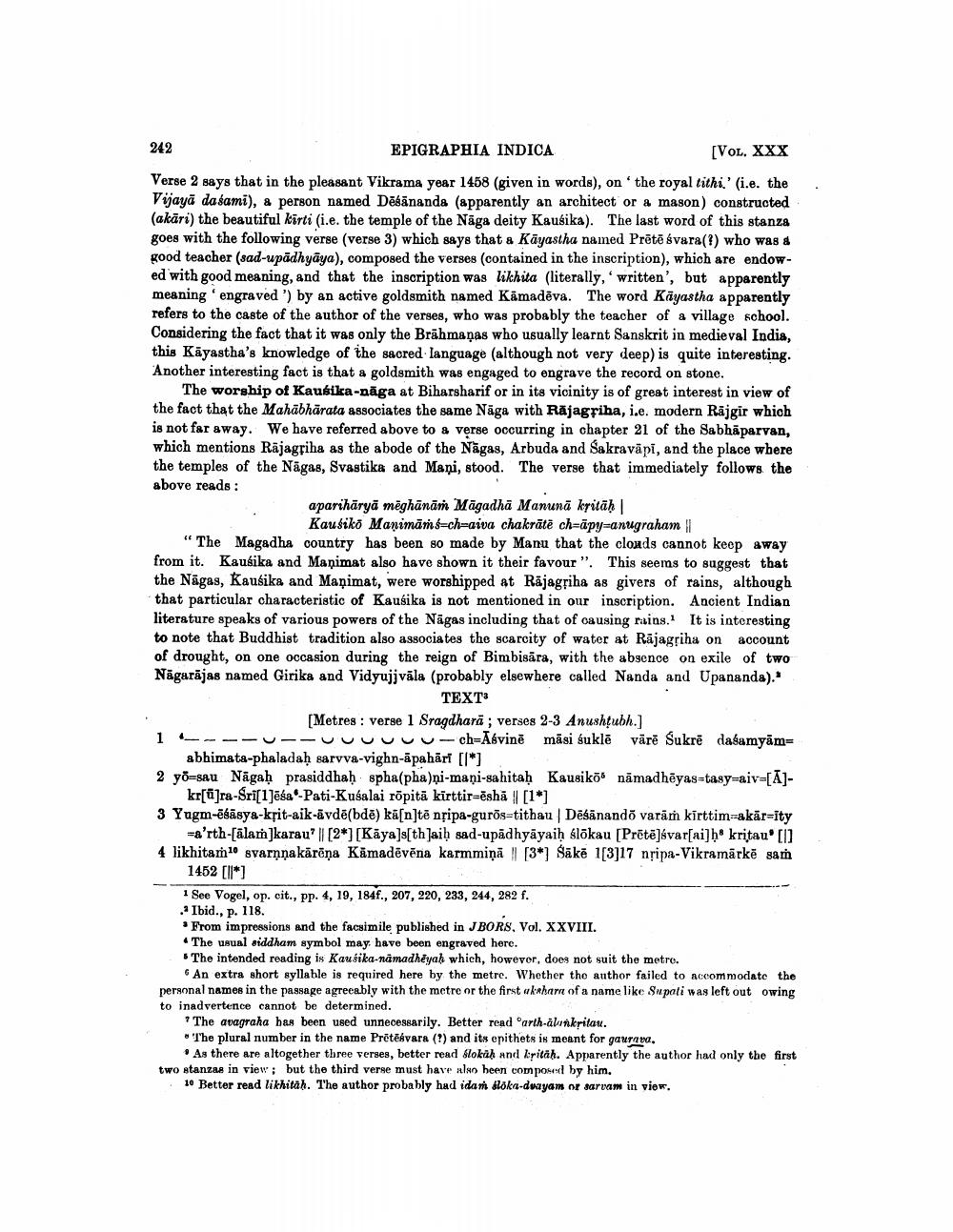________________
242
EPIGRAPHIA INDICA
[VOL. XXX
Verse 2 says that in the pleasant Vikrama year 1458 (given in words), on the royal tithi' (i.e. the Vijayā daśami), & person named Dēbānanda (apparently an architect or a mason) constructed (akāri) the beautiful kirti (i.e. the temple of the Nāga deity Kausika). The last word of this stanza goes with the following verse (verse 3) which says that a Kāyastha named Prētē śvara(?) who was a good teacher (sad-upādhyāya), composed the verses (contained in the inscription), which are endowed with good meaning, and that the inscription was likhita (literally, written', but apparently meaning engraved ') by an active goldsmith named Kamadēva. The word Kāyastha apparently refers to the caste of the author of the verses, who was probably the teacher of a village school. Considering the fact that it was only the Brāhmaṇas who usually learnt Sanskrit in medieval India, this Kāyastha's knowledge of the sacred language (although not very deep) is quite interesting. Another interesting fact is that a goldsmith was engaged to engrave the record on stone.
The worship of Kausika-näga at Biharsharif or in its vicinity is of great interest in view of the fact that the Mahābhārata associates the same Näga with Rājagriha, i.e. modern Rājgir which is not far away. We have referred above to & verse occurring in chapter 21 of the Sabhāparvan, which mentions Rājagriha as the abode of the Nāgas, Arbuda and Sakravāpi, and the place where the temples of the Nāgas, Svastika and Mani, stood. The verse that immediately follows the above reads:
apariharya mēghānāṁ Magadhā Manunā kritäh
Kausiko Manimāms-ch-aiva chakrāte ch-äpy-anugraham | "The Magadha country has been so made by Manu that the clouds cannot keep away from it. Kausika and Manimat also have shown it their favour". This seems to suggest that the Nāgas, Kausika and Manimat, were worshipped at Rājagriha as givers of rains, although that particular characteristic of Kausika is not mentioned in our inscription. Ancient Indian literature speaks of various powers of the Nāgas including that of causing rains. It is interesting to note that Buddhist tradition also associates the scarcity of water at Rājagriha on account of drought, on one occasion during the reign of Bimbisära, with the absence on exile of two Nägarājas named Girika and Vidyujjvāla (probably elsewhere called Nanda and Upananda)."
ТЕХта
[Metres : verse 1 Sragdharā ; verses 2-3 Anushtubh.] 1 ---U--uuuuuu-ch=Asvinē māsi suklē varē Sukrë daśamyām
abhimata-phaladaḥ sarvva-vighn-äpahārt [1] 2 yo-sau Nāgaḥ prasiddhah spha(pha)ņi-mani-sahitaḥ Kausikö nämadhēgas-tasy-aiv=[A]
kr[ūra-Sri[1]ēša. Pati-Kusalai rõpitä kirttir=ēsha || [1*1 3 Yugm-ēśāsya-kțit-aik-āvdë(bdē) kā[n]tē nặipa-gurās=tithau | Dēsānando varām kirttimakār=ity
a'rth-Cālam]karau' || [2"] [Kaya]s[th Jaib sad-upādhyāyaih slökau [Prötējávarsai]bo kritau [11 4 likhitam svarņņa kārēna Kamadēvēna karmmiņā || [3*) Säkë 1[3]17 nripa-Vikramārkē sam
1452 [11*] 1 See Vogel, op. cit., pp. 4, 19, 184f., 207, 220, 233, 244, 282 f. .. Ibid., p. 118. • From impressions and the facsimile published in JBORS, Vol. XXVIII. • The usual siddham symbol may have been engraved here. The intended reading is Kausika-namadhéyak which, however, does not suit the metre.
An extra short syllable is required here by the metre. Whether the author failed to accommodate the personal names in the passage agreeably with the metre or the first akaham of a name like Supati was left out owing to inadvertence cannot be determined.
* The avagraha has been used unnecessarily. Better read arth-alinkritau. • The plural number in the name Protēkvara (?) and its epithets is meant for gaurava.
• As there are altogether three verses, better read Slokāk and kritäh. Apparently the author had only the first two stanzas in view; but the third verse must have also been composed by him.
10 Better read likhitah. The author probably had idan aloka-dwayam or sarvam in view.




